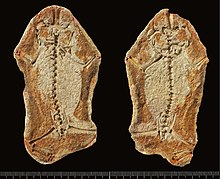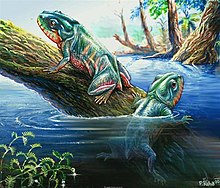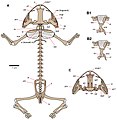Triadobatrachus
| Triadobatrachus | |
|---|---|

| |
| Slabs of the fossil | |
| Scientific classification | |
| Domain: | Eukaryota |
| Kingdom: | Animalia |
| Phylum: | Chordata |
| Class: | Amphibia |
| Genus: | †Triadobatrachus Kuhn, 1962 |
| Species: | †T. massinoti
|
| Binomial name | |
| †Triadobatrachus massinoti (Piveteau, 1936)
| |
Triadobatrachus is an extinct genus of salientian frog-like amphibians, including only one known species, Triadobatrachus massinoti. It is the oldest member of the frog lineage known, and an excellent example of a transitional fossil. It lived during the Early Triassic about 250 million years ago, in what is now Madagascar.

Triadobatrachus was 10 cm (3.9 in) long, and still retained many primitive characteristics, such as possessing at least 26 vertebrae, where modern frogs have only four to nine. At least 10 of these vertebrae formed a short tail, which the animal may have retained as an adult.[1] It probably swam by kicking its hind legs, although it could not jump, as most modern frogs can. Its skull resembled that of modern frogs, consisting of a latticework of thin bones separated by large openings.[2]
This creature, or a relative, evolved eventually into modern frogs, the earliest example of which is Prosalirus, millions of years later in the Early Jurassic.[3]
It was first discovered in the 1930s, when
Although it was found in marine deposits, the general structure of Triadobatrachus shows that it probably lived for part of the time on land and breathed air. Its proximity to the mainland is further borne out by the remains of terrestrial plants found with it, and because most extant amphibians do not tolerate saltwater,[7] and that this saltwater intolerance was probably present in the earliest lissamphibians.[8]
Triadobatrachus is similar in age to the salientian Czatkobatrachus which is known from the Early Triassic (Olenekian) of Czatkowice Poland. [9] [10] [11]
Gallery
-
CT-scan
-
Diagram
-
Cast
-
Life restoration by N. Tamura
References
- ^ .
- ISBN 1-84028-152-9.
- ISBN 0-949324-87-6.
- ^ Piveteau, J. (1936). "Une forme ancestrale des amphibiens anoures dans le Trias inférieur de Madagascar". Comptes Rendus Hebdomadaires des Séances de l'Académie des Sciences. 202: 1607–1608.
- ^ Piveteau, J. (1936). "Origine et évolution morphologique des amphibiens anoures". Comptes Rendus Hebdomadaires des Séances de l'Académie des Sciences. 203: 1084–1086.
- ^ Rage,J-C; Roček, Z. (1989). "Redescription of Triadobatrachus massinoti (Piveteau, 1936) an anuran amphibian from the Early Triassic". Palaeontographica Abteilung A. 206: 1–16.
- S2CID 83659304.
- S2CID 85374803.
- ^ Evans, S.E.; Borsuk−Białynicka, M. (1998). "A stem-group frog from the early Triassic of Poland". Acta Palaeontologica Polonica. 43: 573–580.
- ^ Evans, S.E.; Borsuk−Białynicka, M. (2009). "The Early Triassic stem−frog Czatkobatrachus from Poland" (PDF). Palaeontologica Polonica. 65: 79–105. Archived from the original (PDF) on 2015-02-15. Retrieved 2012-12-11.
- ^ Borsuk−Białynicka, M.; Evans, S.E. (2002). "The scapulocoracoid of an Early Triassic stem-frog from Poland". Acta Palaeontologica Polonica. 47: 79–96.
- Benes, Josef. Prehistoric Animals and Plants. Pg. 114. Prague: Artia, 1979.




